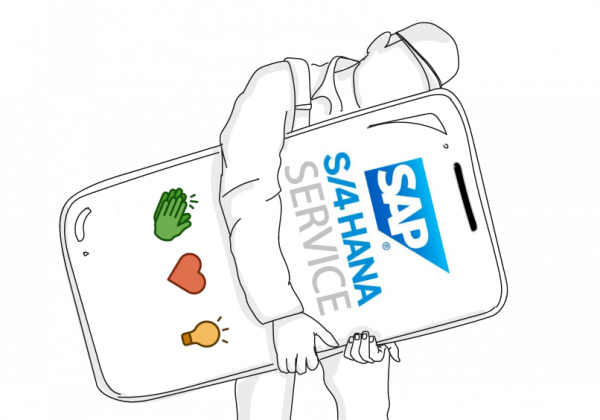Customer service management is an area that was previously handled by SAP ECC’s Customer Service (CS) module, or by Customer Relationship Management (CRM).
The development of S/4HANA brings its share of changes in the world of Customer Service for users and IT teams: the Customer Service module can only be used with SAP S/4HANA within the framework of the Compatibility pack, which expires in 2025/2030 (see SAP note 2269324).
Indeed, the state of the art for dealing with this topic is the use of the S/4HANA Service module.
Whether you’re considering a migration from your existing SAP to S/4HANA, or a new implementation of S/4HANA, this is a topic for you.
The challenge is still to address service-related business needs. However, tools are changing and bringing new features.
Which processes are involved?
The new S/4HANA Service module combines the worlds of CS and CRM. The data model is different, using objects from both original worlds:
- CS module.
- CRM module.
| Features | SAP ERP | S/4HANA Service | SAP CRM |
|---|---|---|---|
| Define company organizational units and repairer groups. | Organization management | ||
| Represents all persons and entities internal and external to the company. | Business Partner | ||
| Represents services, spare parts and fees. | Item | ||
| Materializes the individual item to be tracked. | Equipment | ||
| Locates customers’ fixed installations. | Technical station | ||
| Defines operational parameters for contract preventive maintenance. | Maintenance plan | ||
| Represents the equivalent of maintenance instructions, also known as ranges. | Service order model | ||
| Records the customer’s request or need. | Service request | ||
| Allows you to give the customer a selling price to meet his request or need. | Service offer | ||
| Gives instructions for preparing and carrying out maintenance, but also for other departments: purchasing, inventory and controlling. | Service order | ||
| Entry of time spent by repairer with spare parts taken from stock. | Service confirmation | ||
| Contractualizes the commercial aspects of preventive maintenance with the customer. | Service contract | ||
| Used for parts sold and delivered, to create an outbound delivery. | Sales order | ||
| Builds the logic for defining the sales price (price, discounts, ancillary costs). | Price management | ||
| Invoices all service processes and automatically generates accounting entries. | Billing management | ||
| Manages commercial kits or packages made up of services and parts. | Product package | ||
| Manages a combination of several flows in a single sales document, for a single invoice. | Order of solutions | ||
| Lists problems and defines solutions. | Knowledge base article | ||
As a reminder, as with any module implementation, it’s important to map your business processes in order to define the right fit within the tool.
S/4HANA Service: good reasons to migrate
The S/4HANA Service module also brings new functionalities to adapt to constantly evolving business needs. As this module represents the state of the art in customer service management, SAP will be making enhancements for each new release.
Applium’s selection of new features for the CS module:
- User experience via Lauchpad Fiori for the S/4HANA Service module:
- A clearer presentation of the process and its progress.
- Navigation through the various process objects from one object to another without opening x screens.
- Customization of screens by process:
- Display or reorganization of information blocks within the page.
- Display or reorganization of zones within an information block.
- Product package management:
- Manage commercial parts kits to define a specific price for the kit, versus the sum of the selling prices of each component.
- To be able to offer service packages including service and spare parts.
- Solution orders :
- This is a sales document with the customer, enabling several parallel or successive processes to be combined in a single original document and invoiced in a single final document.
- The sale of goods: then processed by a sales order and the delivery. Ex : sale of a machine.
- Single service sale: succeeded by a service order and the service confirmation. Ex: installation of the machine on your premises.
- The sale of a service contract for preventive maintenance: followed by a service contract. Ex: preventive maintenance performed every 6 months on the machine.
- Link to subscription management tool.
- Integration with Field Service Management (FSM): represents a platform for managing service on the customer site, with:
- Resource planning.
- Management of mobile service reports to communicate information in real time to the customer and for invoicing.
Applium’s opinion: a successful fusion between the CRM Service module and the ERP CS module
The S/4HANA Service module has been available for several versions, and this has enabled SAP to stabilize a solution that is now performing well. The product already has a ” dry ” varnish where we can project ourselves for a new implementation. We’ve done this for a number of customers.
The redesigned ergonomics are a major benefit for users.
For historical users of the CS module, the fundamental question to ask when changing modules is: when to switch to S/4HANA Service?
The devil is in the detail, and an upstream analysis of a conversion project can help define the standard coverage rate of S/4HANA Service in relation to your CS usage.
If a large number of specific features have already been developed for your solution, it’s important to determine whether there is a match in S/4HANA Service, or whether they should be renewed.

